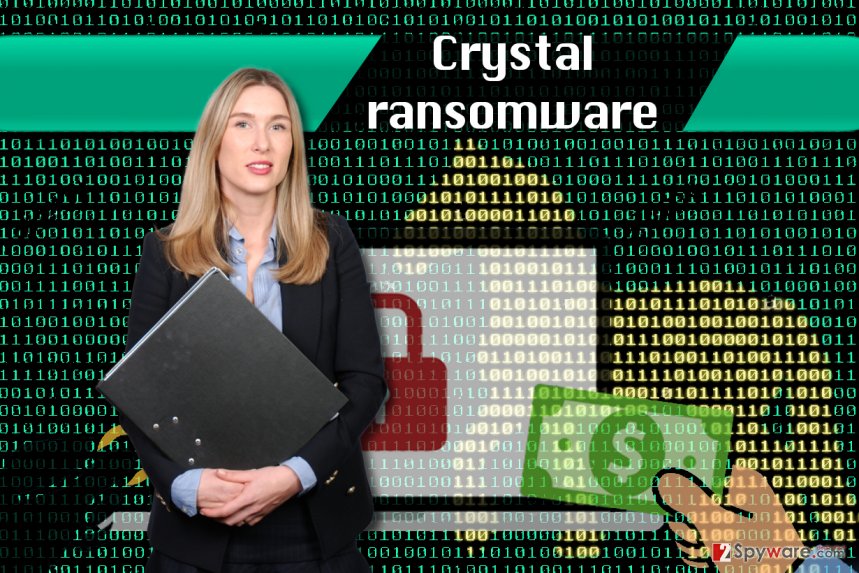Crystal ransomware / virus (Decryption Steps Included) - Free Guide
Crystal virus Removal Guide
What is Crystal ransomware virus?
Crystal ransomware infects the system with the help of additional malware

Crystal ransomware is a computer malware that uses AES encryption to corrupt files on a target computer. The malware disables Windows Firewall to avoid detection. The virus arrives into the system in tandem with a malware downloader and a flooder[1]. The virus aims to thoroughly corrupt victim’s files and demands a ransom.
Once installed on the system, the virus employs Rijndael encryption algorithm[2] (also known as Advanced Encryption Standard or AES) to encode all of the victim’s files. It typically targets pictures, documents, videos, databases and other relevant files.
It goes without saying that the purpose of this virus is not to corrupt the data permanently – the files can be decrypted, but only with the help of a decryption key that is sent to criminals’ servers. Unfortunately, without criminals’ help, there is no way to retrieve this key.
Typically, frauds leave a ransom note asking for a ransom paid in Bitcoins, but in this case, the ransomware doesn’t leave any notes on the system. Cyber security experts assume that this virus is only an in-development version of something more dangerous that might be released in the future.
If you turned on your personal or work computer and found your files marked with .CRYSTAL file extensions, you should immediately run an anti-malware software to wipe the malware off your computer.
For Crystal removal, we strongly suggest using FortectIntego software. It will help you to identify the backdoor, flooder and other malware pieces that came with the ransomware. To remove Crystal virus efficiently, check instructions we added.

Typical behavior of ransomware and distribution techniques used
Ransomware usually spreads via email spam, Trojans, exploit kits and other malware dissemination techniques, says NoVirus.uk experts[3]. While you have to be careful when browsing the Internet, opening emails or visiting unknown Internet sites, it is also very important to prepare for an unexpected ransomware attack properly. Here’s how to do it.
- Ransomware is a malicious program that is usually launched from an executive file. However, cyber criminals tend to obfuscate this file or use .js or .word files as additional tools that look less suspicious, but contain a script that connects to a remote server, downloads and executes the malware.
- To prevent ransomware from corrupting your system, install anti-malware software and create a data backup. These two tasks will prepare you for an unexpected malware infiltration.
- Now, to avoid ransomware viruses in general, we suggest staying away from vague-looking email letters. You must pay attention to the sender’s email address because it is the number one sign revealing that someone’s trying to scam you. If you notice that it looks unprofessional, do not open files or links included in the message.
- Continuously update the programs you have. Download the updates from official software vendors only. Do not trust shady third-party sites or, even worse, pop-up ads!
Remove Crystal ransomware and related malware
Crystal is a virus that infects the computer system with the help of additional malware pieces. Therefore, it is important not only to remove Crystal virus but also the flooder and the backdoor that comes with it. To eliminate these threats, rely on an anti-malware software. Update it to the latest version and attack the malware by running a full system scan.
You can seriously damage your computer system if you try to perform a manual Crystal ransomware removal. The malware is highly sophisticated, and it uses various obfuscation techniques, so it is likely that you won’t find all of its files (unless you are an extremely skilled programmer). Use the guide provided below to clean your computer system.
Getting rid of Crystal virus. Follow these steps
Manual removal using Safe Mode
Crystal removal can be completed only when in Safe Mode with Networking. To put your computer in this mode, you have to use the provided guidelines.
Important! →
Manual removal guide might be too complicated for regular computer users. It requires advanced IT knowledge to be performed correctly (if vital system files are removed or damaged, it might result in full Windows compromise), and it also might take hours to complete. Therefore, we highly advise using the automatic method provided above instead.
Step 1. Access Safe Mode with Networking
Manual malware removal should be best performed in the Safe Mode environment.
Windows 7 / Vista / XP
- Click Start > Shutdown > Restart > OK.
- When your computer becomes active, start pressing F8 button (if that does not work, try F2, F12, Del, etc. – it all depends on your motherboard model) multiple times until you see the Advanced Boot Options window.
- Select Safe Mode with Networking from the list.

Windows 10 / Windows 8
- Right-click on Start button and select Settings.

- Scroll down to pick Update & Security.

- On the left side of the window, pick Recovery.
- Now scroll down to find Advanced Startup section.
- Click Restart now.

- Select Troubleshoot.

- Go to Advanced options.

- Select Startup Settings.

- Press Restart.
- Now press 5 or click 5) Enable Safe Mode with Networking.

Step 2. Shut down suspicious processes
Windows Task Manager is a useful tool that shows all the processes running in the background. If malware is running a process, you need to shut it down:
- Press Ctrl + Shift + Esc on your keyboard to open Windows Task Manager.
- Click on More details.

- Scroll down to Background processes section, and look for anything suspicious.
- Right-click and select Open file location.

- Go back to the process, right-click and pick End Task.

- Delete the contents of the malicious folder.
Step 3. Check program Startup
- Press Ctrl + Shift + Esc on your keyboard to open Windows Task Manager.
- Go to Startup tab.
- Right-click on the suspicious program and pick Disable.

Step 4. Delete virus files
Malware-related files can be found in various places within your computer. Here are instructions that could help you find them:
- Type in Disk Cleanup in Windows search and press Enter.

- Select the drive you want to clean (C: is your main drive by default and is likely to be the one that has malicious files in).
- Scroll through the Files to delete list and select the following:
Temporary Internet Files
Downloads
Recycle Bin
Temporary files - Pick Clean up system files.

- You can also look for other malicious files hidden in the following folders (type these entries in Windows Search and press Enter):
%AppData%
%LocalAppData%
%ProgramData%
%WinDir%
After you are finished, reboot the PC in normal mode.
Remove Crystal using System Restore
-
Step 1: Reboot your computer to Safe Mode with Command Prompt
Windows 7 / Vista / XP- Click Start → Shutdown → Restart → OK.
- When your computer becomes active, start pressing F8 multiple times until you see the Advanced Boot Options window.
-
Select Command Prompt from the list

Windows 10 / Windows 8- Press the Power button at the Windows login screen. Now press and hold Shift, which is on your keyboard, and click Restart..
- Now select Troubleshoot → Advanced options → Startup Settings and finally press Restart.
-
Once your computer becomes active, select Enable Safe Mode with Command Prompt in Startup Settings window.

-
Step 2: Restore your system files and settings
-
Once the Command Prompt window shows up, enter cd restore and click Enter.

-
Now type rstrui.exe and press Enter again..

-
When a new window shows up, click Next and select your restore point that is prior the infiltration of Crystal. After doing that, click Next.


-
Now click Yes to start system restore.

-
Once the Command Prompt window shows up, enter cd restore and click Enter.
Bonus: Recover your data
Guide which is presented above is supposed to help you remove Crystal from your computer. To recover your encrypted files, we recommend using a detailed guide prepared by 2-spyware.com security experts.Speaking of data recovery, the chances to do anything without a data backup are low. If you have a data backup, remove the virus and plug the backup in to import the necessary files. If you don't, we suggest testing these methods.
If your files are encrypted by Crystal, you can use several methods to restore them:
Try Data Recovery Method (Method 1)
The first method to recover your files is to perform a computer scan using Data Recovery Pro software. It helps to identify recoverable files and attempts to fix them. However, when dealing with a sophisticated encryption, it might not be possible to do that without having a decryption key.
- Download Data Recovery Pro;
- Follow the steps of Data Recovery Setup and install the program on your computer;
- Launch it and scan your computer for files encrypted by Crystal ransomware;
- Restore them.
Recover using ShadowExplorer (Method 2)
The second method you can try is to perform a system check using ShadowExplorer. This software allows finding Volume Shadow Copies (if the virus didn't delete them from the system). These copies can be used for data recovery. Sadly, deleting these copies is usually one of the primary tasks that malicious computer programs complete after infecting the system.
- Download Shadow Explorer (http://shadowexplorer.com/);
- Follow a Shadow Explorer Setup Wizard and install this application on your computer;
- Launch the program and go through the drop down menu on the top left corner to select the disk of your encrypted data. Check what folders are there;
- Right-click on the folder you want to restore and select “Export”. You can also select where you want it to be stored.
Finally, you should always think about the protection of crypto-ransomwares. In order to protect your computer from Crystal and other ransomwares, use a reputable anti-spyware, such as FortectIntego, SpyHunter 5Combo Cleaner or Malwarebytes
How to prevent from getting ransomware
Access your website securely from any location
When you work on the domain, site, blog, or different project that requires constant management, content creation, or coding, you may need to connect to the server and content management service more often. The best solution for creating a tighter network could be a dedicated/fixed IP address.
If you make your IP address static and set to your device, you can connect to the CMS from any location and do not create any additional issues for the server or network manager that needs to monitor connections and activities. VPN software providers like Private Internet Access can help you with such settings and offer the option to control the online reputation and manage projects easily from any part of the world.
Recover files after data-affecting malware attacks
While much of the data can be accidentally deleted due to various reasons, malware is one of the main culprits that can cause loss of pictures, documents, videos, and other important files. More serious malware infections lead to significant data loss when your documents, system files, and images get encrypted. In particular, ransomware is is a type of malware that focuses on such functions, so your files become useless without an ability to access them.
Even though there is little to no possibility to recover after file-locking threats, some applications have features for data recovery in the system. In some cases, Data Recovery Pro can also help to recover at least some portion of your data after data-locking virus infection or general cyber infection.
- ^ Flooder - Threat Description. F-Secure. Virus Description Database.
- ^ Joan Daemen, Vincent Rijmen. AES Proposal: Rijndael. NIST. Computer Security Publications.
- ^ NoVirus. NoVirus. Security and Spyware News.





















